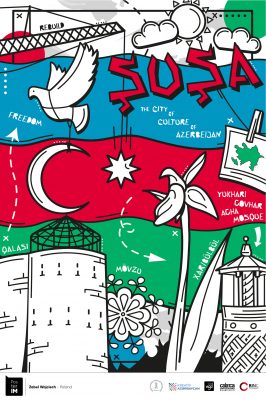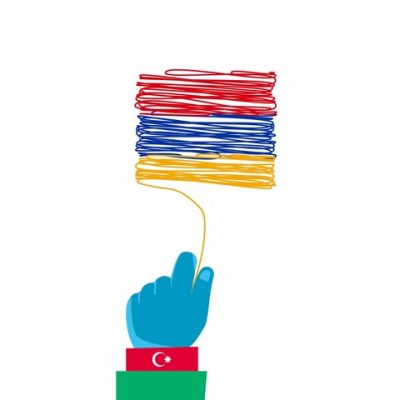Special Report: Azerbaijan's design competition on the occupied city of Shushi

This month has been eventful for Terlan Hacişəmiyev, a graphic designer from Azerbaijan and organizer of a global poster contest under the instruction "Shusha is the cultural city of Azerbaijan." According to Hacişəmiyev, the purpose of this project is "to make the cultural heritage, architecture and symbol of Shusha known to the world." Since June, around 150 graphic designers from 30 countries responded to the call to participate in this space with the expectation that their works will be selected and exhibited at the Ankara University of Music and Fine Arts on August 2.
The Kreativ Azerbaijan program of the Ministry of Culture of this country sponsors the project, together with others, with the aim of promoting the production, dissemination and export of local creative products and services.
Almost 20 artists of different nationalities make up the jury. They have already selected 108 design works that went after the suggested slogan. "The city of Shusha, the cradle of Azerbaijani culture, is written in golden letters in the history of Azerbaijan, distinguished by its national architectural style, has cultivated historical figures of our art and is considered the cradle of mugam," the presentation of the competition states.
Some geographical, historical and cultural references of the region were provided to the participants with the intention of bringing them closer to the theme. One of them was the Caucasian Ophrys flower, represented in the promotional images of this contest, which Azerbaijan considers "the national flower of Karabakh". Another was the plain of Jidir (Jdrduz), where, according to the Azerbaijani voice, the Shusha youth used to race horses.
Graphic designers from all over the world responded positively to Terlan Hacişəmiyev's invitation and sharpened their pencils for the best visual results. Combinations of colors, figures and symbols, mosques, Azerbaijani flags and elements of Azerbaijani music were captured on digital canvases.
Some of the participants of this competition represent Latin American countries. Diario Armenia interviewed them to hear the voices of the creators of aesthetically accomplished design works.
From Cuba, a young 23-year-old designer mentioned that this call quickly spread among her colleagues. "I had a general knowledge about Azerbaijan, but not about the city of Shusha specifically. It was quite a discovery, it really is an important center of the country's culture," the young woman said, admitting that she had to do research on the symbols, architecture and music of the region. Her work leaned towards the representation of the towers of a mosque and the shape of its doors. "I wanted the poster to be an invitation to enter the city, its constructions and symbols."
From the small municipality of Huejotzingo in Mexico, a designer with 10 years of experience, began research on the subject to come up with a graphic solution. As a conclusion, she exclaimed: "It's a wonderful place!", and there he found her inspiration.
A little further north in Mexico, in the city of Durango, a designer who is a university professor and film buff also received an invitation to participate. In his opinion, these contests that revolve around local themes "allow you to get closer and get to know very diverse cultures, perhaps far from our own way of life, in such a way that it not only implies an act of creation, but also an act of learning and understanding". He stated that he has tried to reflect on the significance of Azeri culture; he listened to its music, read its history and turned to its art, gastronomy and architecture. "In the particular case of the poster for Shusha, I was caught by the music and the cultural and historical importance it has for the region; I was especially caught by the shape and sound of the Tar which I find very captivating (...) and to solve the poster, I added the Khari-bulbul flower which, as far as I learned, only grows in that region," commented the artist.

The participant from Bolivia found out about the contest through social networks and did not hesitate to send his work. "I didn't know about the theme of the contest, but there are usually many similar ones about thematic design of tourist cities," he assured. Thus, he began a visual search for characteristic monuments, flora and symbols to create design elements. His work is dominated by architectural forms of mosques and is titled "Cultural Treasures of Azerbaijan".
On the old continent, a Spanish illustrator and graphic designer also responded positively to the invitation. He is convinced that these calls make the world "a little smaller, understandable and, above all, more human". In this case, he chose to represent semicircular door and window arches as the piece that makes up the word Shusha. "A big S is the most prominent component of the poster, two entrances or windows coming from opposite directions and in their merging create the city of Shusha," he explained. According to the artist, culture takes on more importance in cities like this one, "places that, because they are located in the middle of two worlds, are enriched by a knowledge that is a mixture of many. But also, because they are located at the same point, they suffer more pain and conflicts. As humanity, we should be aware that it is in these places, in these points of union, where we grow".
Although architectural elements of the Islamist faith predominated in much of the designs, the Armenian Surp Ghazanchetsots church appeared in some works. A Polish designer depicted it next to a mosque. "Shusha is a city with great traditions. It combines many influences, cultures, religions," he justified.
Based on the participants' comments, prior research on the subject was necessary, and once inspired, let's get to work! This was the unspoken challenge proposed by Terlan Hacişəmiyev, the ideologist of this contest, who, during the last Artsakh war, published on his social networks the design of a hand with the Azerbaijani flag, fraying the Armenian one (see photo).
Azerbaijan has accustomed us to its big lobbying actions; however, whatever the magnitude of the actions, the Azeri task responds to the same objectives of imposing the anti-Armenian vision. Lobbying does not stop being lobbying, even if the issue does not always involve pressure groups running after the public administration of different countries. We went from sponsoring soccer teams to design contests with the same purpose of establishing the Azeri side of reality.
In a world with the Internet as the main source of information, it is expected that the participants of this contest would have entered "Shusha, Azerbaijan" in the search engine. The results would have presented the city as an integral part of Azerbaijan, mentioned that it was occupied by Armenian military units in 1992 and that in 1989, 98% of its population would have been Azerbaijani. But if we try "Shushi"? In this case, the story would have been different; the main images would not have been of mosques but of the Armenian cathedral and probably, images of its deterioration during the last Artsakh war. However, none of the participants commented on the war that was only 10 months old. Neither did they mention Armenia or Artsakh.
For the time being, as a warning, in situations where Azerbaijan's propagandizing bursts into the environment, it would be wise to promote questioning and not to surrender to a Wikipedia-based lobby.
This time art was used as an artifice to hide thousands of Shushi refugees who were forced to leave their homes fleeing the bombings, hundreds of prisoners of war currently captured in Baku, among whom there are also civilians, and Azeri vandalism against Armenian cultural elements. Indeed; Armenian cultural elements. At least on one point the slogan of the contest does have some truth to it: Shushi is a cultural city. But of Artsakh.
* The identity of the contest participants was protected in this article.
Betty Arslanian
Correspondent for the Diario Armenia in Yerevan



